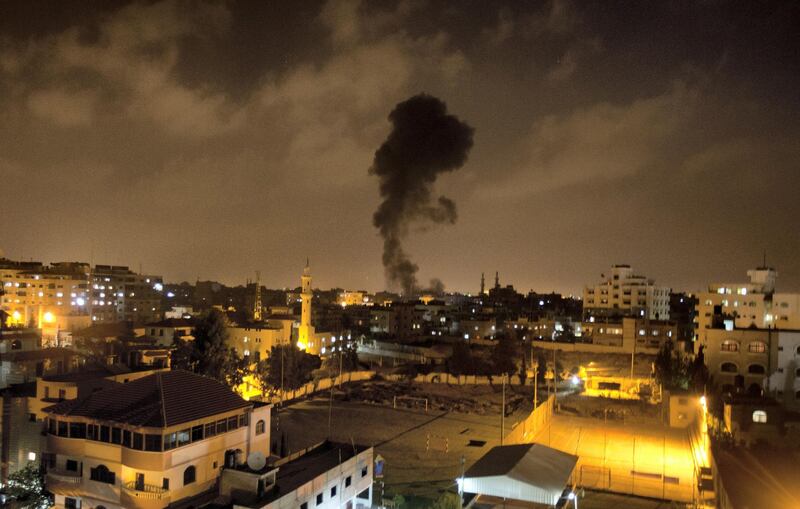Some Gazans brag that they can identify a weapon by its sound, according to Randa, the character who opens Gaza Weddings.
The co-narrator of Ibrahim Nasrallah’s slim novel says she has no such talent. “I mean, when all the sleep you get is a tiny snooze that you manage to fall into by a miracle in the wee hours of the morning, how are you going to be able to tell the difference between banging on a door and bombs going off?”
Loud noises aren't the only things the characters in Gaza Weddings are unable to tell apart. The book, translated by Nancy Roberts and newly published by Hoopoe Fiction, is alternately narrated by Randa, an aspiring journalist, and her neighbour Amna. Both of them mix up people, places, deaths and times.
Gaza Weddings, first published in Arabic in 2004, is part of Nasrallah's Palestinian Comedy project, an eight-novel series in the spirit of Balzac's La Comédie Humaine.
The series has a wide scope, with settings that range from the fictional village of Hadiya during the 17th century Ottoman Empire to Gaza during the First Intifada.
Nasrallah's Time of White Horses, which opens in the 1680s and continues to the establishment of the State of Israel in 1948, is nearly 600 pages of deeply researched social and cultural history that, the author has said, took him more than two decades to write. Gaza Weddings is a markedly different book. This is a slender, ghostly novel, built around wordplay, swapped identities and women. The books are two different histories of two very different Palestines.
“A Palestinian living in the Gaza Strip… has experienced different political and social conditions to those experienced by another living on the West Bank,” Nasrallah said in a 2012 talk at the University of Sheffield. “I would say there are Palestinian peoples, and not a single Palestinian people.”
The two characters who tell us about the world in Gaza Weddings are Amna, a physical therapist who talks to her missing husband, and Randa, who speaks directly to the reader.
We see almost nothing of Randa’s identical twin Lamis, although even their mother can’t tell the two women apart. Only Amna’s son Saleh knows who is who.
Grown men are almost entirely absent in this novel. Randa and Lamis's father has been in an Israeli prison for years, while teenage Saleh's father is in hiding.
The boy was only two months old when his father was first arrested, and, since then, Amna has had mostly stolen encounters with her husband. She describes how he snuck up and followed her, hoping to have a few moments alone, and she no longer recognised him.
Amna narrates: “I remember that time when I didn’t know who you were, and I said, ‘Shame on you! What’s an old man like you doing running after a girl half his age!’ Then you started to laugh your head off, and if you hadn’t, I never would have recognised you.”
She keeps photos of her husband hidden, so that, if the Occupation Forces come, they won’t know what he looks like any longer.
The neighbouring narrators, Amna and Randa, are also confused about each other. When Amna first moved into the neighbourhood, little Randa thought she was an Egyptian film star.
Even when Amna’s identity was firmly established, Randa clung to the mistaken one. And even though years pass with them living side by side, Amna can’t tell Randa and her twin sister Lamis apart.
________________________
Read more:
[ Book review: Biography of Marjorie Hillis is a fascinating account of women’s empowerment ]
[ Book review: 'A Cat, a Man and Two Women' a gentle story told with dexterity ]
[ Book review: A tale of the loneliness of the hunted in The Tiger and the Acrobat ]
________________________
Midway through the novel an unidentified man is killed, and Amna fears it might be her husband. The body is unrecognisable, and more than 20 Gazan women come to the hospital to claim it. Amna spends days at the grave with a large group of women. Within a couple weeks, they start to leave.
“But I’m afraid that if I leave,” Amna says, “some other woman will come along and take him from me.”
Nearly all the deaths are difficult to identify. One of the twins is shot, but was Lamis or Randa? In the end, the narrator tries to keep both identities alive, pretending to be both herself and her twin sister. At some points, she is no longer sure whether she is actually Randa or Lamis.
The book opens as Amna comes to propose a marriage between Lamis and her son Saleh. Yet Amna makes her strange proposal not to Lamis, nor to the girl’s mother, but to her twin sister Randa. She doesn’t involve her son Saleh in the process, either.
As for Amna’s own wedding, the story she tells is equally strange. Her husband Jalal couldn’t get a permit to cross into Gaza for the ceremony. But instead of waiting for an opportunity to cross, as Amna urged him, Jalal smuggled himself into the Strip in a coffin.
Throughout, Gaza Weddings rushes breathlessly from anecdote to anecdote, raising a lot of intriguing possibilities but resolving few. Some of the humorous wordplay loses its force in translation, particularly when the witticisms are footnoted. And some of the intriguing stories about death and loss scarcely appear before they are gone.
Who is still alive at the end of the book? What was real, and what was wishful thinking?
Nasrallah's historical novel Time of White Horses is grounded in real-feeling layers of research, while Gaza Weddings is grounded in confusions, unreality and ghosts. Very different depictions of Palestines and its peoples indeed.






